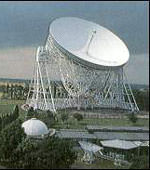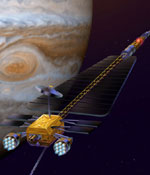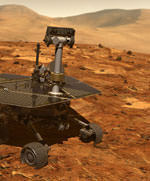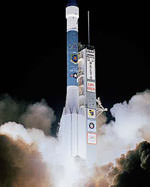
Image credit: PPARC
After NASA’s Mars Odyssey failed to make contact with the British-built Beagle 2 lander on Christmas morning, all hopes were pinned on the Earth-based Jodrell Bank radio telescope to hear its faint signal. After listening for more than two hours, unfortunately, operators failed to tune into the spacecraft’s signal. Then another opportunity to communicate with Odyssey on December 26 failed as well. Mission controllers haven’t completely lost hope, though. When Mars Express reaches its final orbit in early January, it will be the best opportunity to communicate with Beagle 2 and help determine, once and for all, if the spacecraft survived its landing.
Scientists were hopeful that the 250 ft (76 m) Lovell Telescope, recently fitted with a highly sensitive receiver, would be able to pick up the outgoing call from the Mars lander between 19.00 GMT and midnight last night. An attempt to listen out for Beagle’s call home by the Westerbork telescope array in the Netherlands was unfortunately interrupted by strong radio interference.
The next window of opportunity to communicate via Mars Odyssey will open at 17.53 GMT and close at 18.33 GMT this evening, when the orbiter is within range of the targeted landing site on Isidis Planitia.
Another communication session from Jodrell Bank is scheduled between 18.15 GMT and midnight tonight, when Mars will be visible to the radio telescope. It is also hoped that the Stanford University radio telescope in California will be able to listen for the carrier signal on 27 December.
The Beagle 2 team plans to continue using the Mars Odyssey spacecraft as a Beagle 2 communications relay for the next 10 days, after which the European Space Agency’s Mars Express orbiter will become available.
Mars Express, which was always planned to be Beagle 2’s main communication link with Earth, successfully entered orbit around the planet on 25 December and is currently being manoeuvred into its operational polar orbit.
Meanwhile, 13 more attempts to contact Mars Odyssey have been programmed into Beagle 2’s computer. If there is still no contact established after that period, Beagle 2 is programmed to move into auto-transmission mode, when it will send a continuous on-off pulse signal throughout the Martian daylight hours.
The first window of opportunity to communicate with Beagle 2 took place at around 06.00 GMT yesterday, when NASA’s Mars Odyssey spacecraft flew over the planned landing site. In the absence of a signal from the 33 kg lander, the mission team contacted Jodrell Bank to put their contingency plan into operation.
At present, Beagle 2 should be sending a pulsing on-off signal once a minute (10 seconds on, 50 seconds off). Some 9 minutes later, this very slow “Morse Code” broadcast should reach Earth after a journey of some 98 million miles (157 million km).
Although the Beagle’s transmitter power is only 5 watts, little more than that of a mobile phone, scientists are confident that the signal can be detected by the state-of-the-art receiver recently installed on the Lovell Telescope. However, a significant drop in signal strength would require rigorous analysis of the data before it could be unambiguously identified.
Although the ground-based radio telescopes will not be able to send any reply, the new information provided by detection of the transmission from Beagle 2 would enable the mission team to determine a provisional location for Beagle 2. This, in turn, would allow the communications antenna on Mars Odyssey to be directed more accurately towards Beagle 2 during the orbiter’s subsequent overhead passes.
Original Source: PPARC News Release








